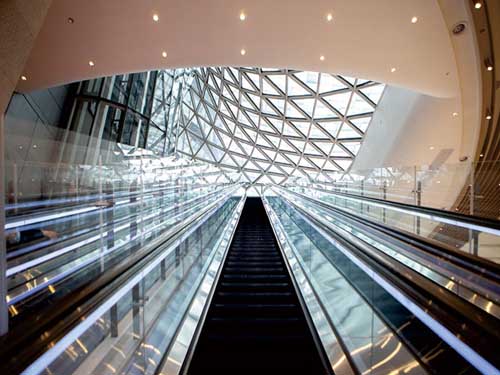Escalators vs Moving Walkways: Which One to Choose?
Most of us have probably used escalators and moving walkways without even thinking about how these fixtures can make our lives easier. The two may sound similar, but escalators and moving walkways are very different. We look at their major differences and how these differences affect their use in different stations.
Escalators vs Moving Walkways: Definition
In short, an escalator is a moving staircase that carries people vertically, while an auto walk is an automated walkway that carries people horizontally.
Commercial Escalator 35° for Mall
Escalators
Escalators are shaped like stairs and they are designed to move people up and down different levels. Passengers on an escalator can choose to stand or walk on the escalator, and moving railings are part of the escalator system. Escalators are usually found in pairs, with one going down and one going up to transport people. The angle of inclination is usually between 30 and 35 degrees.
Moving Walkways
While escalators transport people between floors or heights in a vertical fashion, moving walkways are like slow conveyors that transport people over horizontal distances. Sometimes, just like escalators, they transport people up ramps and between floors. They are usually installed in airports and, like escalators, passengers can use railings for support or stand or walk.
Again, like escalators, moving walkways sometimes come in pairs, transporting people in opposite directions. The angle of incline is much narrower or smaller than for escalators; the angle of an auto walk may be 0 to 6 degrees.
Supermarket Automatic Moving Walk
Escalators and Moving Walkways: Important Differences
Both escalators and moving walkways support optimal traffic flow for commercial and other property types, although they may do so in slightly different ways. Both types are quite energy-intensive, but energy-efficient technologies can be used.
Vehicular traffic flow
Escalators allow businesses to connect different floors and direct large volumes of traffic through certain areas in a specific sequence. Inclined escalators can help sites achieve the same type of multi-level connections. Horizontal escalators connect horizontally related spaces, allowing crowds to move more efficiently and quickly through large spaces as necessary, such as airports and train stations.
Both types support rapid, self-service movement across spaces. They can support higher customer density and mobility, which in turn may lead to higher sales and profitability. Therefore, when it comes to traffic flow, the direction of movement is the key point of difference between the two - horizontal and vertical.
Automatic Moving Walk for Airport
Energy efficiency
For moving walkways and escalators, energy consumption depends heavily on total running time and passenger capacity. energy efficiency measures such as LED lighting and efficient motors can have a significant impact on energy savings. In addition, using smaller motors to match the load (rather than assuming a maximum load) can help with both types of energy savings.
Sites can also use motor efficiency controllers (MECs) to improve efficiency during partial loads. mECs support regenerative braking, which effectively turns the motor into a generator as passengers are transported down the line. This energy can be used for lighting and other applications in the building.
Different modes of escalators and moving walkways can also improve energy efficiency. Intermittent drives with sensor systems support these different modes. For example, your station could use continuous operation mode, which would be the most energy-efficient setting. Walk-and-stop mode can provide on-demand transportation by powering down to standby when no one is on the escalator or moving the walkway.
Or, you can use the crawl mode for continuous operation, which automatically turns on when no one is on the escalator or moving walkway. At the same time, crawl mode will turn off when a passenger approaches.
BDFUJI has many years of experience in elevator design, installation, and maintenance. If you are looking for an elevator, escalator, or moving walkway solution for your property, please contact us today to discuss.




评论
发表评论